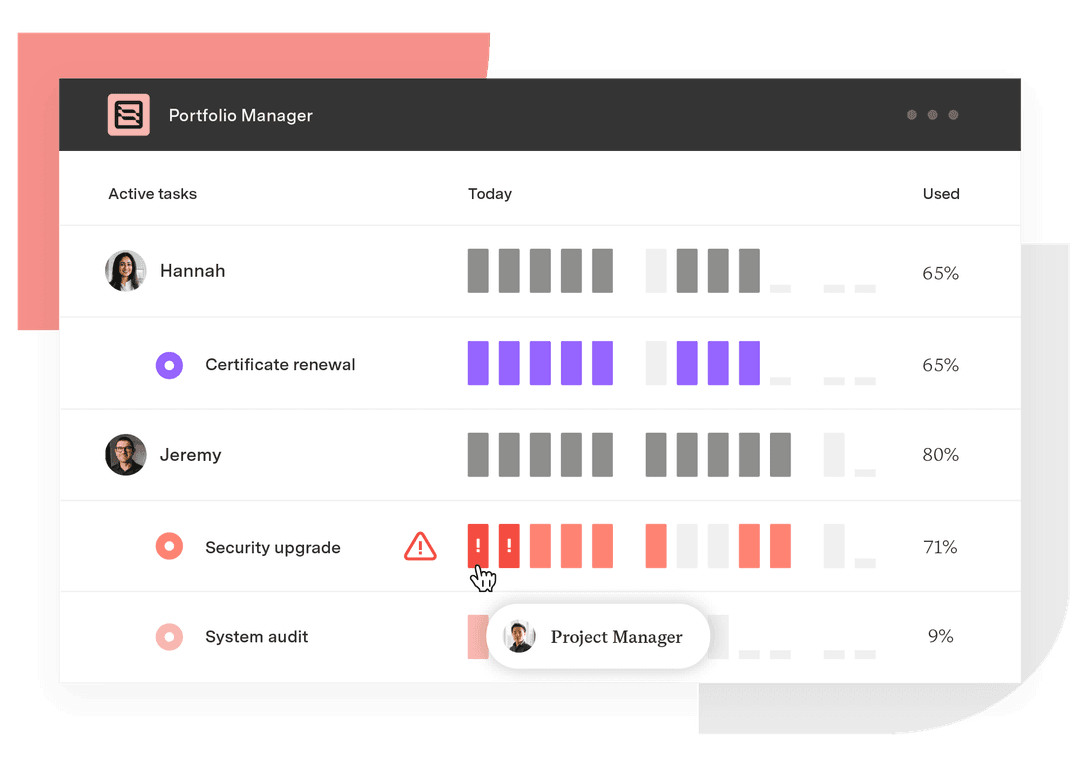Impact of resource constraints on project delivery and how to overcome them
Tempo Team
When essential resources like time, budget, or personnel become limited, a project faces roadblocks. Resource constraints derail even the most well-planned projects, forcing teams to make tough decisions when allocating limited funds, adjusting timelines, or shifting staff. How a team navigates these challenges can make or break a project.
Keep reading to discover the most common resource constraints project managers face and strategies to overcome them.
What are the key resource constraints in project management?
Resource constraints occur when time, money, talent, or technology are unavailable or insufficient to meet project goals. Here are five of the most frequent constraints that impact project success:
Time constraints
Time limitations often create a vicious cycle in project management. Tight deadlines force teams to work at an accelerated pace, leading to increased stress and reduced attention to detail. Overworked employees are more prone to mistakes, which require reworking – further consuming time and effort. Additionally, teams facing time constraints may cut corners or settle for suboptimal solutions to meet deadlines.
Delays or changes in project timelines also create a ripple effect across the entire project. A setback in one phase can push back dependent tasks, causing scheduling conflicts. And if one team falls behind, others may be forced to wait, leading to idle time or rushed work later.
Extended timelines also increase costs, as more work hours and resources are required to compensate for lost time. Finally, shifting deadlines erode stakeholder confidence, which adds pressure to deliver results quickly – often at the expense of quality or team well-being.
Cost constraints
Budget limitations are another challenge in project planning. When costs exceed the initial allocation, project managers must decide where to cut expenses or how to secure additional funding. These decisions often come with trade-offs, such as reduced quality or narrowed project scope.
Exceeding the budget may force teams to find cheaper alternatives, such as lower-quality materials or less-experienced personnel. Although they may be able to obtain extra funds, this is typically a time-consuming process that requires stakeholder approval. If funding isn’t available, teams may need to reprioritize deliverables and push nonessential tasks to future phases.
Cost overruns are particularly problematic in large projects. Minor miscalculations can result in substantial financial losses that impact the current project and affect the organization’s ability to fund future initiatives.
Skill or resource availability
A shortage of the right skills or resources hinders project progress. If the team lacks the necessary expertise or tools, progress slows, and the quality of deliverables suffers.
A skills gap within the team often means employees must spend extra time learning on the job or working through trial and error, both of which delay progress. Project managers may need to hire external consultants to fill the gap, which increases costs and introduces delays as new staff members get up to speed. If hiring isn’t an option, existing team members may have to take on unfamiliar responsibilities, increasing stress and the risk of mistakes.
Similarly, lacking essential tools or equipment can cause delays. Outdated or missing resources force teams to rely on inefficient workarounds, which waste time and reduce productivity. Even minor gaps in available tools can lead to frustration and hinder the team’s ability to meet deadlines or maintain quality standards.
Scope constraints
A project's scope defines what must be delivered, by when, and within what limitations. When the scope expands beyond initial expectations, it strains resources and increases costs.
Scope creep is a common risk where small changes accumulate over time, often without proper review or adjustments to the schedule and budget. Even minor additions, such as extra features or expanded deliverables, require additional time and funding. If not carefully managed, scope creep can reduce the project’s effectiveness.
Customer requirements
Client expectations are an essential consideration for project success, but changes in customer requirements can create uncertainty. If project teams don’t understand what the customer wants from the outset, they may waste time revising work or adjusting priorities.
Frequent changes in customer requirements also lead to shifting deadlines and increased costs. Each adjustment – whether it’s a feature modification or an added deliverable – demands additional time and effort.
What causes resource constraints in project management?
Resource constraints arise from various internal and external factors. Understanding these causes helps teams identify where the most significant challenges lie and how to address them.
Limited resource availability
Limited availability occurs when the required resources – such as personnel, equipment, or technology – are unavailable when needed. Limitations are usually due to competing organizational priorities that spread resources too thin.
For example, a software development company working on multiple projects might require the same senior developers across several teams. If too many projects are scheduled at once, these key personnel may become overbooked, causing delays across all projects. Some teams may have to wait for available developers, slowing progress and forcing managers to either adjust timelines or outsource tasks – both of which come with risks and trade-offs.
Budgetary restrictions
Budgetary constraints often arise from shifting business priorities or inaccurate cost estimates. Poor initial budgeting can lead to funding shortfalls, and external factors like economic downturns or reduced stakeholder investment may force organizations to cut costs mid-project. Additionally, competing projects within the organization can divert financial resources, leaving teams with less funding than initially planned.
Unrealistic project timelines
Overly ambitious timelines pressure teams to accomplish too much in too little time. Unrealistic project timelines often stem from external pressures, such as client demands, market competition, or executive expectations for rapid results. In some cases, stakeholders may underestimate a project’s complexity or fail to account for potential roadblocks, leading to deadlines that don’t align with the project’s scope or available resources.
Changing project scope
A shifting project scope – often due to evolving client expectations or new business priorities – quickly strains resources. Each change typically requires additional effort or direction adjustments, stretching the project team too thin.
How to overcome resource constraints
When resource constraints threaten a project, act early and adjust strategically. Here’s how to navigate these challenges:
Communicate resource shortages early
Be transparent with stakeholders about time, budget, or personnel shortages. Open communication sets realistic expectations and allows for adjustments before the project goes off track. Present data on the constraints and propose potential solutions to secure buy-in for necessary changes.
Prioritize critical tasks
Determine the project’s most critical aspects to allocate resources effectively. Critical path analysis identifies the essential tasks and the minimum duration required to complete the project, helping teams prioritize high-impact activities. They may need to postpone or remove some tasks to keep the project moving forward.
Manage scope to prevent disruptions
Establish clear project boundaries and assess the impact of any changes to the scope. Ongoing communication with stakeholders and a disciplined change management process are vital for controlling scope creep. Properly managed scope adjustments prevent additional strain on resources and keep the project on track.
Adjust the project timeline when necessary
If project deadlines are unrealistic, determine whether you can extend the timeline. Even small extensions give teams the breathing room they need to work efficiently without cutting corners. Prioritize quality over speed, and create achievable timelines to avoid recurring delays.
Reallocate or bring in additional staff
Consider alternative solutions when crucial personnel are unavailable. Options include redistributing workloads among existing team members, bringing in freelancers, or upskilling current staff to fill gaps. Be mindful of workload distribution to prevent burnout while still meeting project needs.
Track time and visualize progress with tools
Analyze how teams spend their time to identify tasks that take longer than expected and reallocate resources accordingly. Additionally, use project management tools like Gantt charts to visualize project timelines and resource distribution, highlighting potential bottlenecks early. This data also supports requests for more time or budget when necessary.
Automate routine tasks
Automate tasks where possible to free up valuable human resources for higher-level work. Project management software handles repetitive work, like data entry, scheduling, or reporting, reducing the burden on staff and improving efficiency. Automation tools save time and money in the short and long term.
Optimize resource management with Tempo
Tempo gives project teams enhanced visibility into time, budget, and resource allocation, enabling them to handle constraints more effectively. Here’s how its solutions support resource management:
Time tracking: Timesheets capture actual work hours, allowing managers to identify overworked employees and redistribute tasks.
Resource planning: Capacity Planner shows team availability, task assignments, and scheduling, reducing conflicts and balancing workloads.
Financial insights: Financial Manager tracks project costs, so teams stay within budget and adjust spending as needed.
Data-driven forecasting: Portfolio Manager runs complex simulations on historical data to predict future resource needs, preventing shortages before they happen – and predicting project completion dates with nearly 100% accuracy.
Tempo empowers teams by providing real-time insights into resource allocation, optimizing decision-making and driving project success. Book a demo today.













































